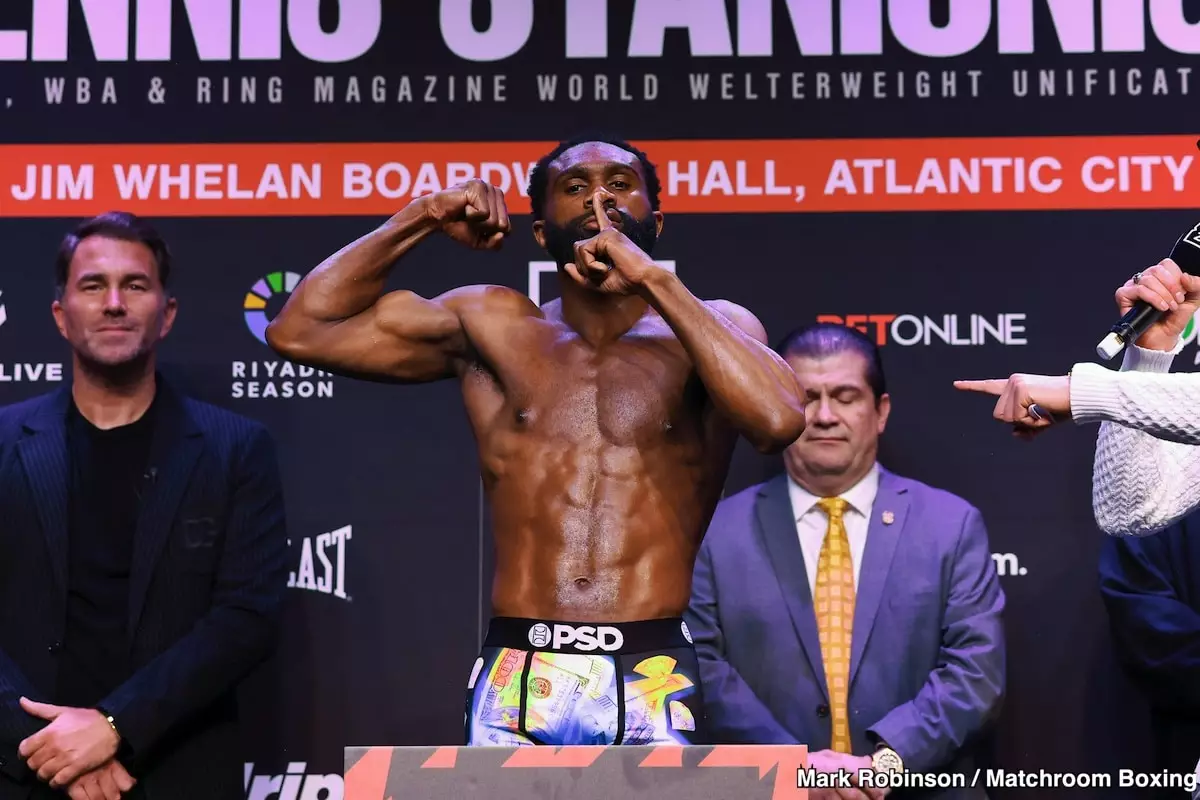This Saturday night, the boxing world holds its breath as Jaron “Boots” Ennis prepares to clash with Eimantas Stanionis for a highly-anticipated IBF and WBA title unification bout at the Boardwalk Hall in Atlantic City, New Jersey. Promoter Eddie Hearn has voiced emphatically that this fight is poised to be the pinnacle of 2025, a sentiment echoed by many fans who crave electrifying matchups. With Ennis holding an impressive record of 33 wins and 29 knockouts, the atmosphere surrounding this bout is charged with excitement and expectation.
Despite the historical achievements of championships like the Ring Magazine belt, which has been earned by legends such as Sugar Ray Leonard and Floyd Mayweather Jr., there is a palpable uncertainty regarding Ennis. Hearn’s predictions of Ennis’s enhanced strength, due to abstaining from the IBF’s secondary weigh-in routine this time around, offer insight into the meticulous nature of weight management in the sport. The alleviation of weight restrictions could be key for Ennis, whose immense frame has previously struggled to fit comfortably within the welterweight limit.
Visualizing Victory: The Battle of Strength
Hearn paints a picture of a more vigorous Ennis, suggesting that freedom from the mental burden of pre-fight weight checks will unleash his true potential. This relief is expected to allow him to perform at his peak, shedding concerns that might have drained him in prior outings, notably in his lackluster defense against Karen Chukhadzhian. Fans remember that bout not for its technical finesse but rather for Ennis’s visible struggle during the weigh-in phase. Fighting with the weight of expectations—and literal weight limitations—can hinder an athlete’s performance. Hearn knows that, and with this new opportunity to operate at full capacity, the stakes are even greater.
The strategic implications of weight management extend far beyond mere numbers on a scale. Not only does Ennis’ physical well-being hinge on how he manages his body leading up to the fight, but his mental condition is equally significant. A focused, well-rested fighter with energy conserved for the match can significantly shift the tide in combat sports, where moments can dictate outcomes. The history of boxers losing their footing under the pressure of rigorous weight classes underscores the importance of this factor.
The Echoes of Previous Performances
Hearn’s candid analysis is enlightening as he points out that Ennis has not yet proven himself in the same candlelit arena as the sport’s greatest. While some may argue that the assessment is too harsh, it is based on Ennis’s past performances; particularly the one against Chukhadzhian. Although he possesses natural prowess, the fleeting inconsistency raises questions about whether he can truly ascend to the lofty levels of boxing royalty. Hearn’s acknowledgment that Ennis has work yet to do speaks volumes to the pressures of the sport and the expectations that come along with it.
The matchup against Stanionis poses genuine challenges that Ennis must navigate thoughtfully. His opponent is a seasoned competitor in his own right, possessing skills that could put a spotlight on Ennis’s vulnerabilities. The boxing community is eager to witness how Ennis will handle this pressure, especially as fans compare him to legends from bygone eras—a burden that no fighter should have to bear prematurely.
A Fight that Makes History?
Both fighters understand that the Ring Magazine title is not just an accolade; it’s a gateway to legacy. Hearn amplifies the narrative that this isn’t merely a contest for belts, but a substantial moment for both fighters to assert themselves firmly in the boxing pantheon. As the engagement approaches, the question remains not only about who will win but also what will be written into the annals of boxing history as a result of this contest.
In many ways, the fight represents a clash not just of fighters but of ambitions—Ennis seeks to validate his burgeoning reputation, while Stanionis aims to carve out his own space in the spotlight. The prelude to this anticipated showdown carries the weight of anticipation, historical significance, and the relentless march of two boxers striving to leave their mark on the sport.
As the bell tolls, the excitement and implications of victory or defeat will reverberate well beyond the squared circle, leaving an indelible imprint on the careers of those involved. The eyes of the boxing world won’t just witness a match; they will engage in the unfolding of a battle steeped in potential, rivalry, and the timeless pursuit of greatness.

